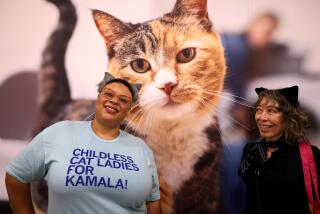‘Jet Sets of Cats’ : For a Legion of Feline Fanciers, Show Circuit Is the Cat’s Meow
- Share via
NEW YORK — There are hairless cats, others with folded ears, some with fur like a velvet lamb’s coat, another with ears bigger than Dumbo’s, and even cats that would have made Ogden Nash rewrite the witticism: “The trouble with a kitten is that eventually it becomes a cat.”
There is one here, a singapura, that almost doesn’t. “The little lion of love” as one breeder calls it, is almost a miniature cat, with females weighing about four pounds, the males six.
There are two California spangled cats, granted instant fame although not recognition as a cat-show breed when Neiman-Marcus listed this little leopard-looking cat as the ultimate Christmas gift for a mere $1,400.
There is a whole supermarket section--elaborate houses that go up to $2,200, a last will and testament your cat can sign, equally inane toys and cat wardrobes, including a little GI camouflage suit that the entrepreneurs have the nerve or the wit, depending upon your point of view, to describe as the ideal outfit for the “serious mouser.”
Karate Cat
That’s not to mention the karate cat outfit, black belted, of course.
And if you are one of those folks who think you have got the world’s smartest cat, forget it. Go watch Marlene, a 5-year-old alley cat who will jump through a hoop on command, sit up like a tiger in a circus performance and then turn in a circle in that position.
It’s all part of the world of cat shows, a world with its own vocabulary and an enormously interested public, since there are an estimated 57 million cats in the United States. One expert said there are 2,000 shows a year. Another said there is at least one show a weekend large enough to command more than 250 entrants.
Some exhibitors ride the circuit, like rodeo riders, presenting their little darlings 30, 40 or 50 times a year as they go for the big titles: things like Supreme Grand Champion, Best of Breed, Best of Best, etc. For those who “campaign” a cat, it’s a way of life.
It’s also almost always a money-losing proposition for the fancier.
“I’ve known of people who have spent $50,000 a year campaigning a cat,” said Michael Brim, editor of Cat Magazine, a monthly based in Daytona Beach, Fla., with a circulation of 175,000. “You can’t sell enough kittens to make that back.”
This particular show, held Super Bowl Sunday in the hometown of the winning team, was, in many ways, the epitome of cat shows. Sponsored by The International Cat Assn. (TICA) in Madison Square Garden, it was enormous, despite the football game, a blizzard and a strike by the Long Island Railroad.
Sixteen judging rings were in operation all three days. More than 30,000 visitors braved the storm to show up, and more than 700 cats competed.
Cats were not only flown across the Atlantic for this one, they came from all corners of the United States--California, Florida, Texas, Ohio, Oregon.
“What you are seeing here are the jet sets of cats,” proclaimed Ellie Silverman, a non-cat owner who handled the publicity. “This is the Olympics of cat shows.”
“The Cat Fancier’s Assn. (CFA) has much better cats in their shows,” was the contrasting opinion of Linda B. Jones of Manhattan, a member of the CFA.
You see, not only do the cats compete, so do the associations. They argue over what constitutes a new breed, when and if it should be recognized, whether a de-clawed feline may compete and sometimes over the precise standards of the breed.
There are half a dozen large associations. The CFA is the largest and most conservative, and TICA is probably the second largest and puts more of an emphasis on genetics and introducing new breeds. The third largest, which is actually the oldest, is the American Cat Assn.
It is partly a world of stage mothers, the kind who simply bask in the glories their baby is winning in the show ring. There are the addicts, cat people who are similar to the young couple who will compulsively drive six or seven hours every single weekend to ski, or the family who spends more on their sailboat than they can afford.
“I’ve seen people who can afford it and people who can’t,” said Allene Sergi, administrative assistant of the CFA, a woman who, incidentally, is allergic to cats. “For most of them, it’s just an expensive hobby. For others, it is bordering on an obsession.”
Vicky Markstein, an IBM scientist when she is not breeding cats, said that to her it’s a way of creating living sculpture. “And,” she adds, “I’m competitive and I love animals.” She also has shown horses and dogs.
“I went all the way to Holland this year to find the right stud for one of my cats,” said Markstein, whose husband, Peter, shares her avocation. He, too, is an IBM scientist. Both are based in Austin, Tex.
The Marksteins were CFA members before they split over the genetics issue. They breed Oriental shorthairs and Siamese, and Peter Markstein relates a wonderful bit of old gossip about a woman who managed to breed Siamese that stayed very light for years and years. Most Siamese darken and they are over the hill as show cats by the time they are 2, whereas the Persian is just coming into its own at 3 and can go on for years.
Abyssinian Secret
“This woman’s Siamese never darkened, and it wasn’t until she was retiring from the business that she confessed that she threw an occasional Abyssinian into the breeding, which genetically allowed the Siamese to hold the color after she bred the Abyssinian features back out.”
Linda Jones, the CFA member, is here because the show is highlighting Cornish rex, a fairly rare breed that has velvety, curly fur and a most outgoing personality. She is showing two 6-month-old kittens, one pure white, one jet black. Last year, Jones campaigned their mother to top honors.
Jones, who manages law firms when she is not changing the cat box, is the first to laugh at herself.
“A boyfriend of mine was sitting on the couch one night, and he said, ‘Linda, your whole apartment moves.’ ” The guy had a point. After extracting a promise not to snitch to the landlord, Jones confided that she has 13 Abyssinians, including two “whole males,” as the studs are invariably called, plus the three rex--all in your basic one-bedroom Manhattan apartment.
Tagging along behind Jones is a soon-to-be-married young couple clearly in the early stages of addiction. Bert Wherry, an actor, and Deborah Sudarsky, who makes television commercials, owned a “mutt cat,” actually a purebred Abyssinian but lacking in show quality features, when they went to their first cat show. They saw the Cornish rex and fell in love with the breed.
They contacted Jones and the brother of these two cats chose them.
“It was a tough decision,” Wherry said. “We’re the kind who feel there are so many animals out there that need homes that we shouldn’t be spending this kind of money on a kitten. We thought it over for 36 hours and went back. This time we acted on our feelings. We bought ‘Slim.’ And we’ve never regretted it.”
May one inquire how much they paid?
“Certainly not,” Wherry said with a laugh. “Let’s just say it was more money than I ever thought I would spend on an animal. Any animal.”
Many exhibitors confess that they got into the throes of buying their first good pedigreed cat by simply attending a cat show and then the avocation took on a life of its own.
This is not the kitten mill crowd, the dealers who put a cat through three pregnancies a year in order to sell the kits to the local pet store. These people disdain such enterprises. Many respectable breeders of top show cats insist that the person who buys one of “pet quality” have it neutered.
“To make money out of cats, you’ve got to have 40 females and have them all pregnant all the time,” said Nigel Morall, a 28-year-old breeder from Queens who plays country-western music in Long Island nightspots to support his cat fetish. He breeds Tonkinese, Abyssinians and Burmese.
Next to him in the “benching area,” i.e., cat cages, was Sue Ford of Columbus, Ohio. She was showing a 9-month-old red Persian called Likur’s Hot Toddy, one of the 19 permanent cats she has at home. Two bedrooms in her house have been converted into catteries. That all started when she innocently walked into a cat show one day.
The most astonishing exhibitors are those who travel around the country showing off their household pets. This is just a cat, which must be neutered to be eligible in this most popular competition.
Bernard and Linda Hayduk of Greenlawn, N.Y., estimate that they spent $3,000 to $5,000 last year competing in the household pet category. They drove to some shows, flew to others. This time, they have brought along Orange Marmalade, a 2-year-old red-and-white tabby.
“We have no children, so we do this,” Linda said.
Cat show people speak here of “laid-back” cats. That generally means the cat couldn’t catch a mouse if his life depended upon it. Some would say dumb. Then there is the opposite euphemism, “outgoing.” This means this little guy has never hidden under anybody’s bed and is afraid of nothing. Judges included. And if he senses that some of his well-timed hissing has a judge a little frightened, watch out.
And, according to Larry Paul, a judge from Atlanta, there are judges who are terrified of cats.
Most Likely to Get Bitten
“I don’t understand why they do it. But there are some judges who are deathly afraid of cats. They are the ones who get bitten. The cats will react. If they feel they can bite, they will,” said Paul, who has bred Persians, Himalayans, Cornish rex, Siamese, Burmese and Abyssinians. He has been handing out ribbons at cat shows for 25 years now and in real life, for the last four years, he has been handing out sentences. Paul is a criminal court judge.
Cats, he said, are simpler.
“You can tell if a cat is good or bad right away. With people, it’s not so easy,” he said.
Judges handle the breeder’s pride and joy for less than a minute. Paul is even quicker. He was clocked at 20 seconds on one cat.
“Some judges will drag it out, but that’s for show. You know right away.”
Cause for Disqualification
Any cat who does bite a judge is automatically disqualified. Too much hissing and snarling costs points. A judge who is qualified as an all-breed judge is paid 50 cents a cat, the specialist judge gets only 35 cents a cat and the household cat judges earn a quarter a cat.
Another judge, Jim Becknell of El Paso, Tex., told the audience that only 10% of the judge’s work is done by sight. The rest is by feel as he really tosses the cat around, stretching it, looking at it from odd angles, feeling the muscle tone, the tail, the balance, the bone alignment.
It varies with breed and can be rather complicated.
For instance, a rather rare cat, the chartreux, is judged by the following formula: head, 15 points; neck, 4 points; ears, 10 points; eyes, 10 points; body, 20 points; tail, 4 points; legs, 6 points; feet, 2 points; coat, 14 points, and color, 15 points.
“One of the things about TICA is that our program does not list whether the entrants are novices or champions,” proudly stated Gloria Stevens, the head of the judges, with a bit of a barb toward other organizations that provide such information.
Well and good, but when Paul was judging 10 Siamese in Ring 8, he volunteered that he had judged three of those cats two weeks ago at a show in Dallas. “I’ll see some of them again in Corpus Christi in two more weeks,” he said.
“I’ve also got the grandson of a cat who had the best stage presence I’ve ever seen in this show. I can’t wait to judge him. Some cats are just showoffs. They know how to look their best.”
More to Read
Sign up for Essential California
The most important California stories and recommendations in your inbox every morning.
You may occasionally receive promotional content from the Los Angeles Times.













